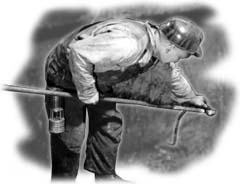



    |
|
|
Early Mining Methods
The journals of English and French sailors in the late 17th and early 18th centuries indicate that coal was being taken from the cliffs along the shore by digging at its base with crow bars. Mining methods did not progress much until the 1780s. Underground mining, assisted by experienced British colliers, began when the mines were operated by the Crown and various merchant concerns. In 1785, a shaft was sunk to the Sydney main seam and the room and pillar method of coal extraction was begun. Picks and wedges were the only tools used to work the coal free from the mine face. The coal was worked by holing across the room in the middle, sheering the sides, and breaking it down by wedging. The coal was loaded in tubs and hauled by manpower to the bottom of the shaft. The tubs were then emptied into a larger one and raised 90 feet to the surface. The coal in the large tub was transferred into a hopper and then into carts which took the coal to the wharf for shipment. 
During the 19th century there were few changes in the room and pillar system of working. The operations at the face required two people. Holes were drilled into the top part of the face by hand augers, later with hand drills and from around 1890 with compressed air drills. When the hole was about six feet deep, a charge of black powder was put in. Then a squib, a small charge of powder contained in a paper tube, was inserted into the hole. The end would protrude out like a fuse. The shot was then fired by lighting the squib with a heated wire. The blast would break up the coal, making it easier to load and transport to the surface. With the arrival of the General Mining Association, new tools, machinery and engines were introduced which added to the efficiency in winning the coal. Later the longwall method was introduced by the Dominion Coal Co. With this system of longwall advance a considerable amount of coal could be obtained soon after mining began. Because the coal was extracted working out from the shaft to the boundries of the seam, roadways and air courses had to be maintained throughout the worked areas of the mine. In the retreating longwall system, the roadways were cut to the boundaries before the face was worked, the coal was then extracted toward the shaft. This method involved a high initial cost and a small output until the mine had been completely developed. |
|
The History |
The Future
Regional Impact | Mining Techniques | The Museum Main | Glossary | Site Map | Text Only |

Created by Virtual Media Productions Ltd., © 1997.
|